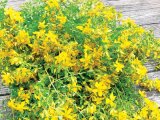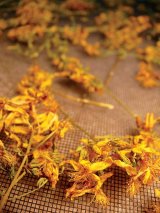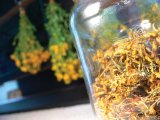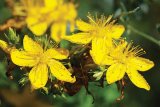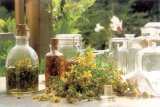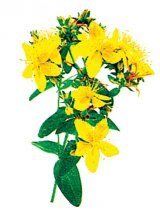The plant of the soul: THE RINGER
* The most powerful natural antidote for sadness and melancholy that appear with the diminution of light, the cooling of the weather and the approaching arrival of winter *
A few years ago, an experiment took place in Germany that would shock the scientific community and, at the same time, give a ray of hope for the millions of people suffering from the disease of the 21st century: DEPRESSION. The experiment we are talking about included over 3000 sufferers, from young people of not even 20 years old, to the elderly over 80 years old, all of whom took St. John's wort extract for four weeks. In dry statistical terms, the experiment was a success - over 80% of the participants noticed significant improvements in their mental state, and only less than 5% faced adverse effects, usually minor, incomparably lower than in the case of synthetic antidepressants. But looking beyond the statistics and figures, the extract from this modest plant proved to be a true miracle. It comforted and gave a desperate helping hand to hundreds of people who could no longer find their place in the world because they suffered from pessimism and devastating sadness, to the poor unfortunates who could not sleep every night because of psychological suffering, or to those who were headed for suicide, as a result of depression. Never before in modern history had there been a natural remedy, experimented on such a scale, and which gave such results, in a condition of great gravity and with a very wide spread. More jokingly, more seriously, one of the 633 doctors who were involved in this experiment said that what antibiotics meant for the 20th century, St. John's wort will mean for the 21st century, when depression begins to be more widespread than infections. However, it would be unfair to believe that the effectiveness of St. John's wort is limited only to depression. Both internally and externally, it has healing properties in many other conditions. Let's see what it is about, first learning some practical things about its administration and preparation.
Business card
St. John's wort (Hypericum perforatum) is a plant that grows spontaneously in all areas of the country, from the sub-mountainous regions to the plains. It is perennial (its root goes into hibernation in winter, so that a new stem can sprout from it in spring), growing up to one meter tall, but most commonly 40-50 centimeters. With its yellow flowers, with leaves with reddish-rusty dots, it is unmistakable. The most powerful therapeutic effects are its flowering tops, which contain several substances that when macerated in water or alcohol give them a very characteristic reddish color.
St. John's wort-based preparations
St. John's wort extract
It is the kind of remedy that people who are subject to intense mental stress, who have sleep disorders or who have a pronounced meteosensitivity should always have on hand. It is obtained from the tincture of aerial parts of St. John's wort, from which the alcohol completely evaporates, leaving a reddish-brown powder, extremely concentrated in active principles, with a specific odor: St. John's wort extract. It contains several times or dozens of times more active principles than the simple powder or tincture. Moreover, these active principles are fully assimilated by the body, and not just in a proportion of 15-25%, as in the case of the simple powder. As such, the extract is the most concentrated "medicine" that can be obtained from St. John's wort, so it is not surprising that all the studies that we will refer to in the following have used this form of administration. In our country, St. John's wort extract is found combined in equal proportions with St. John's wort herb powder, in the form of capsules, with remarkable therapeutic efficiency. The association of the powder with the extract helps the patient to benefit from the natural, original properties of the plant, making the treatment more efficient. The required doses of extract capsules will be specified for each type of condition.
St. John's wort powder
Grind the dried St. John's wort stems very finely with an electric coffee grinder, then sift through a fine sieve (such as the one for white flour). The powder obtained in this way is stored in hermetically sealed glass jars, in dark and cool places, for a maximum period of 15 days (because the active substances oxidize relatively quickly). As a rule, it is administered 4 times a day, one grated teaspoon, on an empty stomach, at 7, 13, 19 and 22.
Combined St. John's wort infusion
In half a liter of water, 3-4 tablespoons of crushed St. John's wort are soaked for 8-10 hours, then filtered. The resulting preparation is set aside, and the remaining plant is boiled in another half liter of water for five minutes, then allowed to cool and filtered. Finally, the two extracts are mixed, obtaining approximately one liter of combined infusion of St. John's wort, which is used internally (1-2 cups per day).
St. John's wort oil
In half a liter of olive, grape seed or sesame oil, put 10 tablespoons of dried and not very finely chopped St. John's wort flowers. Let the mixture macerate in the sun for 2 weeks, then filter, and the resulting preparation is drawn into a dark bottle, which is kept in dark and cool places.
Preventive treatments
* Diabetes - the latest theories about the occurrence of diabetes show that often the basis of this condition is an emotional imbalance. It seems that people subjected to stress, to emotions such as disappointment, sadness, despair end up having disorders of the pancreas function, which, repeated over time, lead to illness. Refined sugar and concentrated sweets consumed in excess also lead to diabetes, being the most accessible drug, to determine the release of substances (neurotransmitters) in the body, which temporarily compensate for negative mental states. So, if we don't want to become diabetic, we need to keep our stress under control, with natural means, and St. John's wort is perhaps the most handy. The powder is administered 3 teaspoons a day, in 2-4 week courses, during periods of high stress or when we are faced with pronounced emotional tension.
* Indigestion, dyspepsia, irritable bowel syndrome - people who are prone to these conditions should do, 2-3 times a year, a combined infusion of St. John's wort and basil (Ocimum basilicum). One liter is administered per day, in 30-day courses. This remedy is a mild digestive tonic, prevents gastric and intestinal disorders due to stress, regulates appetite.
* Panic attacks - several case studies show that a course of St. John's wort extract (800-1200 mg per day), taken for 4 weeks, helps prevent paroxysmal attacks of fear. The extract from this plant helps to keep negative emotions under control, relieves phobias and induces a state of mental and physical tone that helps the patient control their fear.
* Thrombophlebitis - a class of active substances, called coumarins, contained in St. John's wort helps prevent the formation of blood clots and their migration. As such, St. John's wort extract capsules are recommended, 4-6 per day, in courses of 30 days, followed by a 15-day break, to prevent the appearance of this condition. The same St. John's wort extract is a very good adjuvant for those who want to quit smoking, given that this vice is an important risk factor for thrombophlebitis.
Internal treatments
* Meteosensitivity - several studies show that patients who experience anxiety, headaches, sleep and concentration problems due to weather phenomena benefit greatly from treatment with St. John's wort. Patients who suffer from gloomy weather, fog and low light respond best to treatment, as St. John's wort induces a state of mental tone, vivacity and optimism. St. John's wort extract is administered, 800-1000 mg per day, in courses of maximum 6 weeks, followed by a 2-week break.
* Obsessive-compulsive disorders - the capsules with the combination of powder and St. John's wort extract are administered, 4-6 per day, in two-month courses, followed by a one-month break. Numerous patients who have taken St. John's wort to treat other conditions have noted the positive effects of St. John's wort in the case of these disorders. The official studies conducted on this topic are still few and contradictory, but based on practical observations made by doctors, it can be safely stated that in some cases, with the help of St. John's wort, positive results can be obtained for eliminating these disorders or at least for reducing their intensity and frequency.
* Anxiety - is an area in which St. John's wort is not as effective as in the case of depression, but there are many patients who have obtained encouraging results using this plant. It is recommended to alternate the administration of St. John's wort (4-8 capsules per day) with passionflower (Passiflora incarnata), in courses of four weeks each.
* Obesity and weight gain due to emotional imbalances - it is necessary to say in this context that, in fact, there is practically no person who is faced with weight problems and who does not have an emotional problem that underlies this eating disorder. Therefore, many doctors in Germany and the United States have obtained remarkable results, treating obese patients with St. John's wort. Conferring a state of mental tone and alertness, significantly reducing the suffering caused by reducing the amount of food, creating the mood for an active life and for sports, St. John's wort is a true anti-obesity plant. By treating it, one does not only aim to lose a few kilograms, which are put back at the first emotional crisis compensated with abundant food, but one gets much closer to the root of the problem, which is the lifestyle. St. John's wort extract is administered, 1-1.2 grams per day, taken in fractions, in portions, 30-60 minutes before meals.
* Fermentation colitis - St. John's wort powder is administered, one grated teaspoon, four times a day, in 30-day courses, followed by a 21-day break. St. John's wort is taken on an empty stomach, before meals, or at least two hours after eating. The active principles of the plant reduce the number of fermentation bacteria in the intestine, thus regulating the flora, restoring the epithelia and eliminating inflammation. Also, treatment with St. John's wort helps control mental stress, which is among the main factors that lead to the appearance, worsening or recurrence of fermentation colitis.
* Viral hepatitis, chronic and acute - several studies show that some active substances in St. John's wort (hypericin and hyperforin in particular) attack the viruses that cause hepatitis B and C. Experimental medicine tests conducted in this regard are promising, but clinical trials have not yet been completed. What can be said for sure at the moment is that St. John's wort, even if only as an adjuvant, is of real use in the treatment of hepatitis. It reduces the rate of evolution of the disease, helps to keep emotional tensions under control, which are very dangerous in the case of those with liver problems, protects the liver from destructive processes. St. John's wort extract is recommended, 1 gram per day, in 6-week courses, followed by another 3-week break.
* Insomnia - several studies conducted in institutes in Canada, Germany and the United Kingdom analyzed the way in which St. John's wort influences sleep. It was found that St. John's wort does not help us fall asleep faster, instead, it increases the period of deep dreamless sleep (the most restful phase of sleep), increases the production of melatonin (the hormone of restful sleep), makes waking up in the morning easier. St. John's wort extract is administered, 400 mg, 3 times a day, the last dose at 10 pm. It is a simple treatment, which will make sleep more restful and regenerative, even if it will not significantly increase the period of time we sleep.
* Alcohol and nicotine addiction - experimental animals treated with St. John's wort, after they had been induced to be addicted to alcohol or nicotine, showed much fewer negative symptoms, once these drugs were suddenly stopped. In practice, it has been found that patients who have decided to give up these vices have a much greater chance of success if they follow a treatment with St. John's wort, which on the one hand reduces the suffering of the adaptation period, and on the other hand helps to mobilize psychic resources to overcome this moment. In other words, although it does not take the place of drugs and is not a substitute for willpower, St. John's wort is of real use for overcoming the addiction threshold. St. John's wort extract is administered, 1.5 grams in the first week of treatment, reducing the dose in the following weeks, up to 1 gram per day. A cure lasts 6 weeks and will be followed by another 3-4 weeks of break, after which the treatment is resumed.
* Premenstrual syndrome - observations made on patients by American doctors Bratman (1997) and Rosenthal (1999) show that the mental state of women with premenstrual syndrome is greatly improved with the help of St. John's wort. Symptoms such as mental irritability, depression, attention and concentration deficit, mental hyper-excitability are reduced, all correlated with the period before menstruation or even during menstruation. The same doctors have noted similar effects of St. John's wort in the case of premenopausal disorders. St. John's wort powder is administered, one teaspoon four times a day, in 28-day courses, with a 10-14-day break.
External applications
* Burns of minor and moderate severity - at the first application, wash with a cotton pad very well moistened with St. John's wort tincture. Immediately after drying the skin, apply St. John's wort oil liberally. 2-3 such applications are made daily, taking care that the skin is not exposed to the sun for 24 hours after using the St. John's wort preparation.
* Bruises - hold a compress with St. John's wort tincture on the affected area. The sensation of pain will be diminished, the lesion will heal faster and will be less obvious in the different phases of healing.
* Open wounds - wash with St. John's wort tincture, then leave the wound to air, to heal quickly. 2-3 such applications are made per day. They reduce pain, prevent infection and accelerate the healing and scarring process.
* Atopic dermatitis - apply St. John's wort oil three times a day, until complete healing. Several studies have confirmed the healing action of St. John's wort in this condition.
Adverse reactions to treatment with St. John's wort
Given that there are already millions of constant users of St. John's wort, the adverse effects of this plant are very well known. All studies conducted so far show that the percentage of those who have adverse reactions is very low (under 5% with St. John's wort, compared to 31% with allopathic medicines), and these reactions are minor. The most common is excessive sensitivity of the body to light (photosensitivity), especially to sunlight, which can cause skin burns, eye discomfort, headaches. Therefore, people undergoing treatment with St. John's wort should not expose themselves to the sun between 11 am and 6 pm. Other possible adverse effects of internal and external treatment with St. John's wort are dry mouth, temporary dizziness, skin rashes and temporary itching, very rarely difficulty falling asleep, gastrointestinal disorders. The specialized literature also mentions several isolated cases (reported to millions of users) of worsening tachycardia, anxiety symptoms, concentration disorders, and depression in those who were already taking chemical medication for this condition.
Precautions and contraindications for treatment with St. John's wort
The first contraindication to this plant is for those who are simultaneously taking synthetic drugs for depression and anxiety, for insomnia, for epilepsy, or for HIV infection.
There is a possibility that you are allergic to this plant, which is why you will initially take St. John's wort in small doses (one tenth of the normal dose), gradually increasing the dose to the prescribed one. St. John's wort allergy manifests itself through skin rashes, pain or gastrointestinal discomfort.
As a rule, a treatment lasts between one and three months, after which a break of 2-4 weeks is taken, and then the treatment can be resumed. Strictly follow this recommendation! Otherwise, neuralgia, sleep disorders, skin irritations and other symptoms may occur. St. John's wort is not addictive, and studies show that its effects are maintained for a considerable period of time, after the cessation of treatment.
St. John's wort extract and depression
The study that I mentioned at the beginning of the article and which was coordinated by Professor Dr. H. Woelk is just one of dozens that prove the value of St. John's wort extract in the treatment of depression. Many other studies, of a smaller or larger scale, confirm that St. John's wort is extremely effective in combating various forms of depression, as well as its psycho-emotional complications. For this reason, St. John's wort extract has become the most administered medicine in the European Union against this condition. Even in the refractory America, where the chemical-pharmaceutical industry has an overwhelming influence, the prescription of this plant in the form of an extract has become the first therapeutic option for many psychiatrists with depressed patients. What exactly does St. John's wort extract do? First of all, it causes the cerebral cortex to release certain neurotransmitters, natural substances that induce positive emotional states: optimism, enthusiasm, tone. Then, this plant attenuates, through neurological mechanisms that are only partially known, feelings of pessimism, inner emptiness, paralyzing guilt. Studies on depressed patients who took St. John's wort showed that after just two weeks of treatment, most of them overcame their asthenia, gained confidence in their own strength, and began to give up that negative self-evaluation, which is one of the main characteristics of this condition. During the St. John's wort treatment, the extract is administered, for a better effect and to avoid adverse reactions, in equal proportions with the plant powder. The daily dose of the extract will be between 600 and 1200 mg, administered in three doses, for a period of 4-6 weeks, followed by another two-week break, after which the administration can be resumed.
A few years ago, an experiment took place in Germany that would shock the scientific community and, at the same time, give a ray of hope for the millions of people suffering from the disease of the 21st century: DEPRESSION. The experiment we are talking about included over 3000 sufferers, from young people of not even 20 years old, to the elderly over 80 years old, all of whom took St. John's wort extract for four weeks. In dry statistical terms, the experiment was a success - over 80% of the participants noticed significant improvements in their mental state, and only less than 5% faced adverse effects, usually minor, incomparably lower than in the case of synthetic antidepressants. But looking beyond the statistics and figures, the extract from this modest plant proved to be a true miracle. It comforted and gave a desperate helping hand to hundreds of people who could no longer find their place in the world because they suffered from pessimism and devastating sadness, to the poor unfortunates who could not sleep every night because of psychological suffering, or to those who were headed for suicide, as a result of depression. Never before in modern history had there been a natural remedy, experimented on such a scale, and which gave such results, in a condition of great gravity and with a very wide spread. More jokingly, more seriously, one of the 633 doctors who were involved in this experiment said that what antibiotics meant for the 20th century, St. John's wort will mean for the 21st century, when depression begins to be more widespread than infections. However, it would be unfair to believe that the effectiveness of St. John's wort is limited only to depression. Both internally and externally, it has healing properties in many other conditions. Let's see what it is about, first learning some practical things about its administration and preparation.
Business card
St. John's wort (Hypericum perforatum) is a plant that grows spontaneously in all areas of the country, from the sub-mountainous regions to the plains. It is perennial (its root goes into hibernation in winter, so that a new stem can sprout from it in spring), growing up to one meter tall, but most commonly 40-50 centimeters. With its yellow flowers, with leaves with reddish-rusty dots, it is unmistakable. The most powerful therapeutic effects are its flowering tops, which contain several substances that when macerated in water or alcohol give them a very characteristic reddish color.
St. John's wort-based preparations
St. John's wort extract
It is the kind of remedy that people who are subject to intense mental stress, who have sleep disorders or who have a pronounced meteosensitivity should always have on hand. It is obtained from the tincture of aerial parts of St. John's wort, from which the alcohol completely evaporates, leaving a reddish-brown powder, extremely concentrated in active principles, with a specific odor: St. John's wort extract. It contains several times or dozens of times more active principles than the simple powder or tincture. Moreover, these active principles are fully assimilated by the body, and not just in a proportion of 15-25%, as in the case of the simple powder. As such, the extract is the most concentrated "medicine" that can be obtained from St. John's wort, so it is not surprising that all the studies that we will refer to in the following have used this form of administration. In our country, St. John's wort extract is found combined in equal proportions with St. John's wort herb powder, in the form of capsules, with remarkable therapeutic efficiency. The association of the powder with the extract helps the patient to benefit from the natural, original properties of the plant, making the treatment more efficient. The required doses of extract capsules will be specified for each type of condition.
St. John's wort powder
Grind the dried St. John's wort stems very finely with an electric coffee grinder, then sift through a fine sieve (such as the one for white flour). The powder obtained in this way is stored in hermetically sealed glass jars, in dark and cool places, for a maximum period of 15 days (because the active substances oxidize relatively quickly). As a rule, it is administered 4 times a day, one grated teaspoon, on an empty stomach, at 7, 13, 19 and 22.
Combined St. John's wort infusion
In half a liter of water, 3-4 tablespoons of crushed St. John's wort are soaked for 8-10 hours, then filtered. The resulting preparation is set aside, and the remaining plant is boiled in another half liter of water for five minutes, then allowed to cool and filtered. Finally, the two extracts are mixed, obtaining approximately one liter of combined infusion of St. John's wort, which is used internally (1-2 cups per day).
St. John's wort oil
In half a liter of olive, grape seed or sesame oil, put 10 tablespoons of dried and not very finely chopped St. John's wort flowers. Let the mixture macerate in the sun for 2 weeks, then filter, and the resulting preparation is drawn into a dark bottle, which is kept in dark and cool places.
Preventive treatments
* Diabetes - the latest theories about the occurrence of diabetes show that often the basis of this condition is an emotional imbalance. It seems that people subjected to stress, to emotions such as disappointment, sadness, despair end up having disorders of the pancreas function, which, repeated over time, lead to illness. Refined sugar and concentrated sweets consumed in excess also lead to diabetes, being the most accessible drug, to determine the release of substances (neurotransmitters) in the body, which temporarily compensate for negative mental states. So, if we don't want to become diabetic, we need to keep our stress under control, with natural means, and St. John's wort is perhaps the most handy. The powder is administered 3 teaspoons a day, in 2-4 week courses, during periods of high stress or when we are faced with pronounced emotional tension.
* Indigestion, dyspepsia, irritable bowel syndrome - people who are prone to these conditions should do, 2-3 times a year, a combined infusion of St. John's wort and basil (Ocimum basilicum). One liter is administered per day, in 30-day courses. This remedy is a mild digestive tonic, prevents gastric and intestinal disorders due to stress, regulates appetite.
* Panic attacks - several case studies show that a course of St. John's wort extract (800-1200 mg per day), taken for 4 weeks, helps prevent paroxysmal attacks of fear. The extract from this plant helps to keep negative emotions under control, relieves phobias and induces a state of mental and physical tone that helps the patient control their fear.
* Thrombophlebitis - a class of active substances, called coumarins, contained in St. John's wort helps prevent the formation of blood clots and their migration. As such, St. John's wort extract capsules are recommended, 4-6 per day, in courses of 30 days, followed by a 15-day break, to prevent the appearance of this condition. The same St. John's wort extract is a very good adjuvant for those who want to quit smoking, given that this vice is an important risk factor for thrombophlebitis.
Internal treatments
* Meteosensitivity - several studies show that patients who experience anxiety, headaches, sleep and concentration problems due to weather phenomena benefit greatly from treatment with St. John's wort. Patients who suffer from gloomy weather, fog and low light respond best to treatment, as St. John's wort induces a state of mental tone, vivacity and optimism. St. John's wort extract is administered, 800-1000 mg per day, in courses of maximum 6 weeks, followed by a 2-week break.
* Obsessive-compulsive disorders - the capsules with the combination of powder and St. John's wort extract are administered, 4-6 per day, in two-month courses, followed by a one-month break. Numerous patients who have taken St. John's wort to treat other conditions have noted the positive effects of St. John's wort in the case of these disorders. The official studies conducted on this topic are still few and contradictory, but based on practical observations made by doctors, it can be safely stated that in some cases, with the help of St. John's wort, positive results can be obtained for eliminating these disorders or at least for reducing their intensity and frequency.
* Anxiety - is an area in which St. John's wort is not as effective as in the case of depression, but there are many patients who have obtained encouraging results using this plant. It is recommended to alternate the administration of St. John's wort (4-8 capsules per day) with passionflower (Passiflora incarnata), in courses of four weeks each.
* Obesity and weight gain due to emotional imbalances - it is necessary to say in this context that, in fact, there is practically no person who is faced with weight problems and who does not have an emotional problem that underlies this eating disorder. Therefore, many doctors in Germany and the United States have obtained remarkable results, treating obese patients with St. John's wort. Conferring a state of mental tone and alertness, significantly reducing the suffering caused by reducing the amount of food, creating the mood for an active life and for sports, St. John's wort is a true anti-obesity plant. By treating it, one does not only aim to lose a few kilograms, which are put back at the first emotional crisis compensated with abundant food, but one gets much closer to the root of the problem, which is the lifestyle. St. John's wort extract is administered, 1-1.2 grams per day, taken in fractions, in portions, 30-60 minutes before meals.
* Fermentation colitis - St. John's wort powder is administered, one grated teaspoon, four times a day, in 30-day courses, followed by a 21-day break. St. John's wort is taken on an empty stomach, before meals, or at least two hours after eating. The active principles of the plant reduce the number of fermentation bacteria in the intestine, thus regulating the flora, restoring the epithelia and eliminating inflammation. Also, treatment with St. John's wort helps control mental stress, which is among the main factors that lead to the appearance, worsening or recurrence of fermentation colitis.
* Viral hepatitis, chronic and acute - several studies show that some active substances in St. John's wort (hypericin and hyperforin in particular) attack the viruses that cause hepatitis B and C. Experimental medicine tests conducted in this regard are promising, but clinical trials have not yet been completed. What can be said for sure at the moment is that St. John's wort, even if only as an adjuvant, is of real use in the treatment of hepatitis. It reduces the rate of evolution of the disease, helps to keep emotional tensions under control, which are very dangerous in the case of those with liver problems, protects the liver from destructive processes. St. John's wort extract is recommended, 1 gram per day, in 6-week courses, followed by another 3-week break.
* Insomnia - several studies conducted in institutes in Canada, Germany and the United Kingdom analyzed the way in which St. John's wort influences sleep. It was found that St. John's wort does not help us fall asleep faster, instead, it increases the period of deep dreamless sleep (the most restful phase of sleep), increases the production of melatonin (the hormone of restful sleep), makes waking up in the morning easier. St. John's wort extract is administered, 400 mg, 3 times a day, the last dose at 10 pm. It is a simple treatment, which will make sleep more restful and regenerative, even if it will not significantly increase the period of time we sleep.
* Alcohol and nicotine addiction - experimental animals treated with St. John's wort, after they had been induced to be addicted to alcohol or nicotine, showed much fewer negative symptoms, once these drugs were suddenly stopped. In practice, it has been found that patients who have decided to give up these vices have a much greater chance of success if they follow a treatment with St. John's wort, which on the one hand reduces the suffering of the adaptation period, and on the other hand helps to mobilize psychic resources to overcome this moment. In other words, although it does not take the place of drugs and is not a substitute for willpower, St. John's wort is of real use for overcoming the addiction threshold. St. John's wort extract is administered, 1.5 grams in the first week of treatment, reducing the dose in the following weeks, up to 1 gram per day. A cure lasts 6 weeks and will be followed by another 3-4 weeks of break, after which the treatment is resumed.
* Premenstrual syndrome - observations made on patients by American doctors Bratman (1997) and Rosenthal (1999) show that the mental state of women with premenstrual syndrome is greatly improved with the help of St. John's wort. Symptoms such as mental irritability, depression, attention and concentration deficit, mental hyper-excitability are reduced, all correlated with the period before menstruation or even during menstruation. The same doctors have noted similar effects of St. John's wort in the case of premenopausal disorders. St. John's wort powder is administered, one teaspoon four times a day, in 28-day courses, with a 10-14-day break.
External applications
* Burns of minor and moderate severity - at the first application, wash with a cotton pad very well moistened with St. John's wort tincture. Immediately after drying the skin, apply St. John's wort oil liberally. 2-3 such applications are made daily, taking care that the skin is not exposed to the sun for 24 hours after using the St. John's wort preparation.
* Bruises - hold a compress with St. John's wort tincture on the affected area. The sensation of pain will be diminished, the lesion will heal faster and will be less obvious in the different phases of healing.
* Open wounds - wash with St. John's wort tincture, then leave the wound to air, to heal quickly. 2-3 such applications are made per day. They reduce pain, prevent infection and accelerate the healing and scarring process.
* Atopic dermatitis - apply St. John's wort oil three times a day, until complete healing. Several studies have confirmed the healing action of St. John's wort in this condition.
Adverse reactions to treatment with St. John's wort
Given that there are already millions of constant users of St. John's wort, the adverse effects of this plant are very well known. All studies conducted so far show that the percentage of those who have adverse reactions is very low (under 5% with St. John's wort, compared to 31% with allopathic medicines), and these reactions are minor. The most common is excessive sensitivity of the body to light (photosensitivity), especially to sunlight, which can cause skin burns, eye discomfort, headaches. Therefore, people undergoing treatment with St. John's wort should not expose themselves to the sun between 11 am and 6 pm. Other possible adverse effects of internal and external treatment with St. John's wort are dry mouth, temporary dizziness, skin rashes and temporary itching, very rarely difficulty falling asleep, gastrointestinal disorders. The specialized literature also mentions several isolated cases (reported to millions of users) of worsening tachycardia, anxiety symptoms, concentration disorders, and depression in those who were already taking chemical medication for this condition.
Precautions and contraindications for treatment with St. John's wort
The first contraindication to this plant is for those who are simultaneously taking synthetic drugs for depression and anxiety, for insomnia, for epilepsy, or for HIV infection.
There is a possibility that you are allergic to this plant, which is why you will initially take St. John's wort in small doses (one tenth of the normal dose), gradually increasing the dose to the prescribed one. St. John's wort allergy manifests itself through skin rashes, pain or gastrointestinal discomfort.
As a rule, a treatment lasts between one and three months, after which a break of 2-4 weeks is taken, and then the treatment can be resumed. Strictly follow this recommendation! Otherwise, neuralgia, sleep disorders, skin irritations and other symptoms may occur. St. John's wort is not addictive, and studies show that its effects are maintained for a considerable period of time, after the cessation of treatment.
St. John's wort extract and depression
The study that I mentioned at the beginning of the article and which was coordinated by Professor Dr. H. Woelk is just one of dozens that prove the value of St. John's wort extract in the treatment of depression. Many other studies, of a smaller or larger scale, confirm that St. John's wort is extremely effective in combating various forms of depression, as well as its psycho-emotional complications. For this reason, St. John's wort extract has become the most administered medicine in the European Union against this condition. Even in the refractory America, where the chemical-pharmaceutical industry has an overwhelming influence, the prescription of this plant in the form of an extract has become the first therapeutic option for many psychiatrists with depressed patients. What exactly does St. John's wort extract do? First of all, it causes the cerebral cortex to release certain neurotransmitters, natural substances that induce positive emotional states: optimism, enthusiasm, tone. Then, this plant attenuates, through neurological mechanisms that are only partially known, feelings of pessimism, inner emptiness, paralyzing guilt. Studies on depressed patients who took St. John's wort showed that after just two weeks of treatment, most of them overcame their asthenia, gained confidence in their own strength, and began to give up that negative self-evaluation, which is one of the main characteristics of this condition. During the St. John's wort treatment, the extract is administered, for a better effect and to avoid adverse reactions, in equal proportions with the plant powder. The daily dose of the extract will be between 600 and 1200 mg, administered in three doses, for a period of 4-6 weeks, followed by another two-week break, after which the administration can be resumed.
